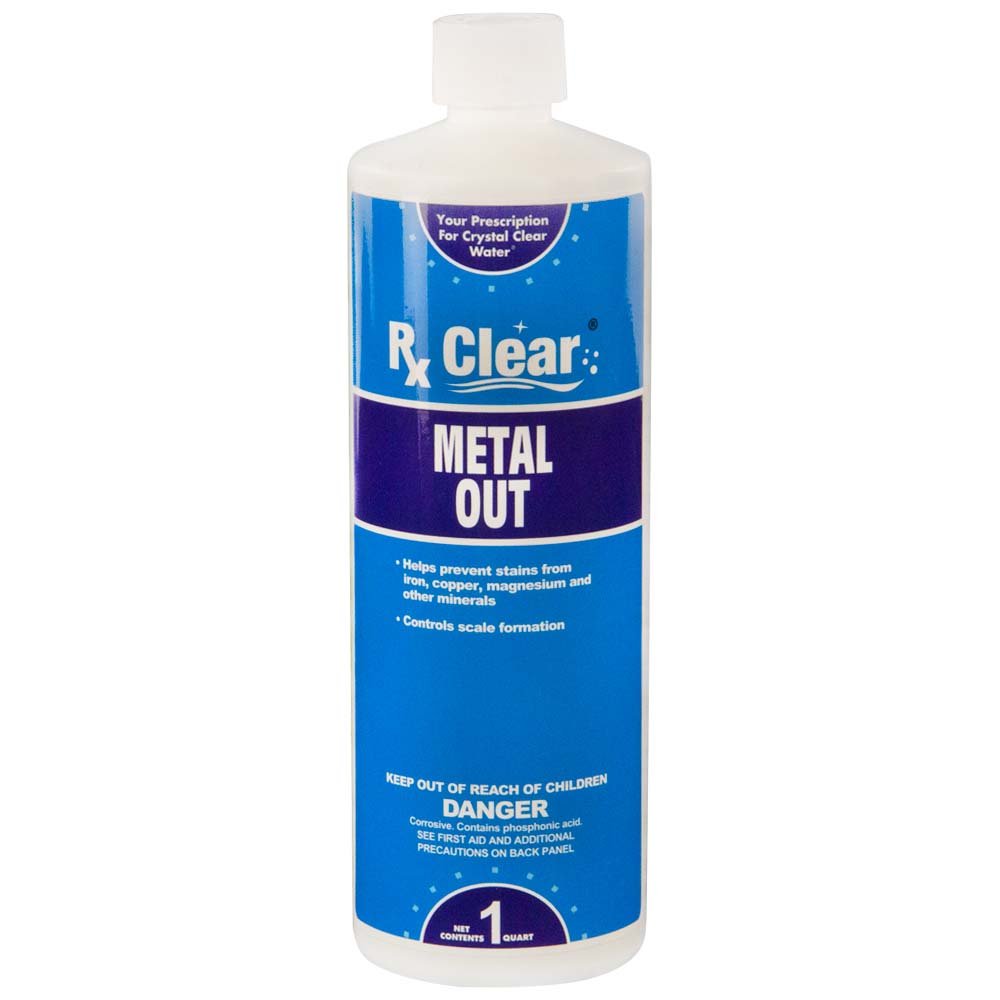7 Chemicals You Need For Opening Your Pool This Spring

It’s spring again, so it’s time to open your pool! While there are many things to consider when opening your pool for the season, one of the most important is your pool start-up chemicals. These chemicals kickstart your pool after it’s been closed all winter and prepare your water for swimming.
PoolSupplies.com suggests getting all the chemicals you need to open your pool with Rx Clear® Pool Opening Kits. We offer regular and deluxe chemical kit options, suitable for both above ground and inground pools, with different amounts of chemicals depending on the size of your pool.
Keep reading to learn more about one of the deluxe kits. We'll examine each chemical and explain how it’s essential to the pool opening process.
Need to know how many gallons are in your pool? We have a blog that talks you through how to calculate it: How to Calculate Gallons in a Pool (Without Overthinking It)

Swimming pool shock is a powdered form of chlorine that raises the pool's free chlorine level to kill contaminants like algae, bacteria, and chloramines effectively.
Free Chlorine is the active form of chlorine that sanitizes the water, destroying bacteria, algae, chloramines, and other contaminants that can compromise the quality and safety of your water. By killing contaminants and breaking down chloramines, shock contributes to clearer water by removing the haze they cause. It also helps to restore the pool’s water chemistry balance, ensuring that the water is properly sanitized and safe for swimming.
Regular shock treatments, usually weekly or bi-weekly, can also help prevent future problems such as excessive algae growth or high chloramine levels. Shocking the pool after winter oxidizes any built-up contaminants and resets sanitizer levels. Routine shock treatments are necessary for maintaining a clear, clean, sanitized, and algae-free pool.
|
How Much Shock Do I Need?
|
|
Water is Clean and Clear
|
1lb per 10,000 gallons
|
|
Water is Teal Green
|
2lbs. per 10,000 gallons
|
|
Water is Dark Green
|
3lbs. per 10,000 gallons
|
|
Water is Black Green
|
4lbs. per 10,000 gallons
|

Pool metal remover prevents or removes unsightly stains caused by dissolved metals. These metals, primarily copper, manganese, and iron, can discolor pool surfaces and equipment.
Adding a metal remover in the spring helps remove stains, scale buildup, and cloudy water caused by dissolved metals introduced through source water, pool equipment, or algaecide. This helps maintain the clarity and appearance of your pool water.
|
How Much Metal Remover Do I Need?
|
|
Pool Opening
|
15oz. per 10,000 gallons
|
|
Scale Build-Up
|
7.5oz. per 10,000 gallons
|
|
Scale Prevention
|
2-4oz. per 10,000 gallons
|

During the winter, algae can develop and take hold in a pool, especially in areas with poor circulation. If not treated proactively with an algaecide, just a few living algae cells can quickly bloom into a full algae outbreak.
Algae thrive in warm, sunlit conditions, and spring is the perfect time for this! Algaecide can inhibit algae growth before it really takes hold, especially if your pool has been closed over the winter without treatments.
|
How Much Algaecide Do I Need?
|
|
|
5.25ox. per 10,000 gallons
|
|
Weekly Dose
|
3-4oz. per 10,000 gallons
|

Pool pH levels can easily become unstable due to debris buildup and lack of chemical treatment, which is why it’s critical to have both a pH increaser and a pH decreaser on hand when you reopen your pool. pH readjustment chemicals can ensure you can properly balance your water chemistry from the start, before you add sanitizers and algaecides.
For a balanced pool, you must keep the pH between 7.4 - 7.6.
|
How Much pH Increaser/pH Decreaser Do I Need?
|
|
pH Increaser
|
6oz. per 10,000 gallons to raise your pH by 0.2
|
|
pH Decreaser
|
5oz. per 10,000 gallons to lower your pH by 0.2
|

Dirt, debris, and other particles can accumulate in the water over the winter, leading to cloudy or hazy conditions when the pool is first refilled.
Using a clarifier when opening your swimming pool can help clear up the cloudy water quicker. It works by causing tiny suspended particles to coagulate into larger particles that can be effectively filtered out. This allowed the pool’s filtration system to easily remove the built-up grime and particulate matter, restoring optimal water clarity and sparkle.
|
How Much Clarifier Do I Need?
|
|
|
5oz per 10,000 gallons
|
|
|
1oz per 10,000 gallons
|

In addition to balancing the pH level, achieving the proper total alkalinity is critical when reopening a pool after winter. Total alkalinity, which measures the amount of carbonates, bicarbonates and hydroxides in the water, helps stabilize pH levels. If the alkalinity is too low when starting up the pool, the pH will be prone to bouncing up and down continuously
This is why it's important to use an alkalinity increaser, typically sodium bicarbonate. Adding an alkalinity increaser raises the alkalinity to adequate levels, acting as a pH buffer that prevents the pH from fluctuating wildly. Balanced total alkalinity makes it easier to keep pH locked into the proper range of 7.2 - 7.8 throughout the entire swimming season. Alkalinity adjustment is a key part of getting the pool's chemistry correctly established at opening.
|
How Much Alkalinity Increaser Do I Need?
|
|
To raise your alkalinity by 10PPM
|
1.5lbs. per 10,000 gallons
|

Chlorine stabilizers and conditioners are crucial chemicals, typically made from cyanuric acid. They help protect and extend the life of the chlorine used to sanitize pool water over the swim season. However, ultraviolet rays from sunlight can rapidly degrade and deplete chlorine levels in outdoor pools if they are not properly stabilized.
Adding the recommended amount of conditioner based on pool volume helps make chlorine last longer by preventing UV degradation. It essentially "conditions" the chlorine to withstand sunlight. Using a stabilizer at opening ensures chlorine will remain effective instead of getting burned off too quickly by the sun's UV throughout the season.
|
How Much Stabilizer and Conditioner Do I Need?
|
|
For Pool Opening
|
2lbs. per 10,000 gallons
|
FAQs
Do I Need To Test My Pool Water Before Adding Chemicals?
Yes! It’s crucial to test your pool water before adding any chemicals. This allows you to see the current chemical levels and what adjustments are needed.
Check out our blog post "How to Easily Test Your Pool" for a comprehensive but easy-to-follow guide.
What Should The Chemical Levels Be In My Pool?
To keep pool water for swimmers, protect your pool equipment, and effectively disinfect the water, your pool should be kept within the following levels:
|
What Should The Chemical Levels Be In My Pool?
|
|
Chemical
|
Range
|
Testing Frequency
|
|
Total Alkalinity
|
100 - 150 PPM
|
Weekly
|
|
pH
|
7.4 - 7.6
|
Weekly
|
|
Chlorine
|
1 - 3 PPM
(free chlorine)
|
Weekly
|
|
Bromine
(for bromine pools)
|
2 - 5 PPM
|
Weekly
|
|
Calcium Hardness
|
175 - 225 PPM (vinyl and fiberglass pools)
200 - 275 PPM (concrete and plaster pools)
|
Monthly
(and at the beginning of the pool season)
|
|
Cyanuric Acid
|
30 - 50 PPM
|
Monthly
(or if you're having issues with your chlorine)
|
In What Order Should I Add The Opening Chemicals?
The generally recommended order for adding opening chemicals is to balance your alkalinity, then pH, stabilizer, and chlorine. Once your chlorine is stabilized, you add your algaecide.
Always add your chemicals one at a time, allowing them to dissolve and circulate before adding the next.
How Long After Adding Chemicals Can I Swim?
This depends on what chemicals you have added! A good rule of thumb is to wait about 20-30 minutes.
|
How Long Should I Wait After Adding Chemicals To My Pool To Swim?
|
|
pH, Alkalinity, and Water Clarifier
|
20 minutes - 1 hour
|
|
Calcium Chloride
|
2 - 4 hours, or one full filtration cycle
|
|
Shock
|
Once chlorine levels reach 5 ppm or lower, or 24 hours
|
|
Muriatic Acid
|
30 minutes
|
|
Algaecide
|
15 minutes
|
|
Flocculant
|
Wait until the floc settles, then vacuum it out before swimming
|
|
Liquid Chlorine
|
4 hours, or until chlorine levels reach 5 ppm or lower
|
Can I Use Leftover Chemicals From Last Year?
Many pool chemicals can be used from the previous year, but some have shorter shelf lives than others, and proper storage is crucial. Liquid chemicals tend to lose effectiveness faster than powders. Always check the shelf life of your chemicals, and make sure to store them properly and safely.






 Pools
Pools Spas
Spas Liners
Liners Equipment
Equipment Covers
Covers Accessories
Accessories Cleaning
Cleaning  Pool Fun
Pool Fun  Clearance
Clearance







